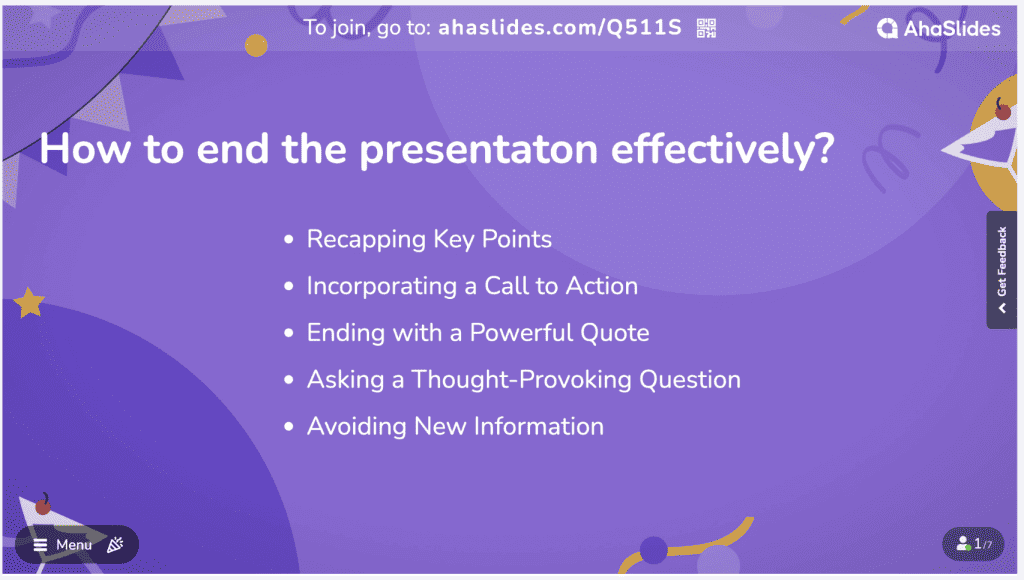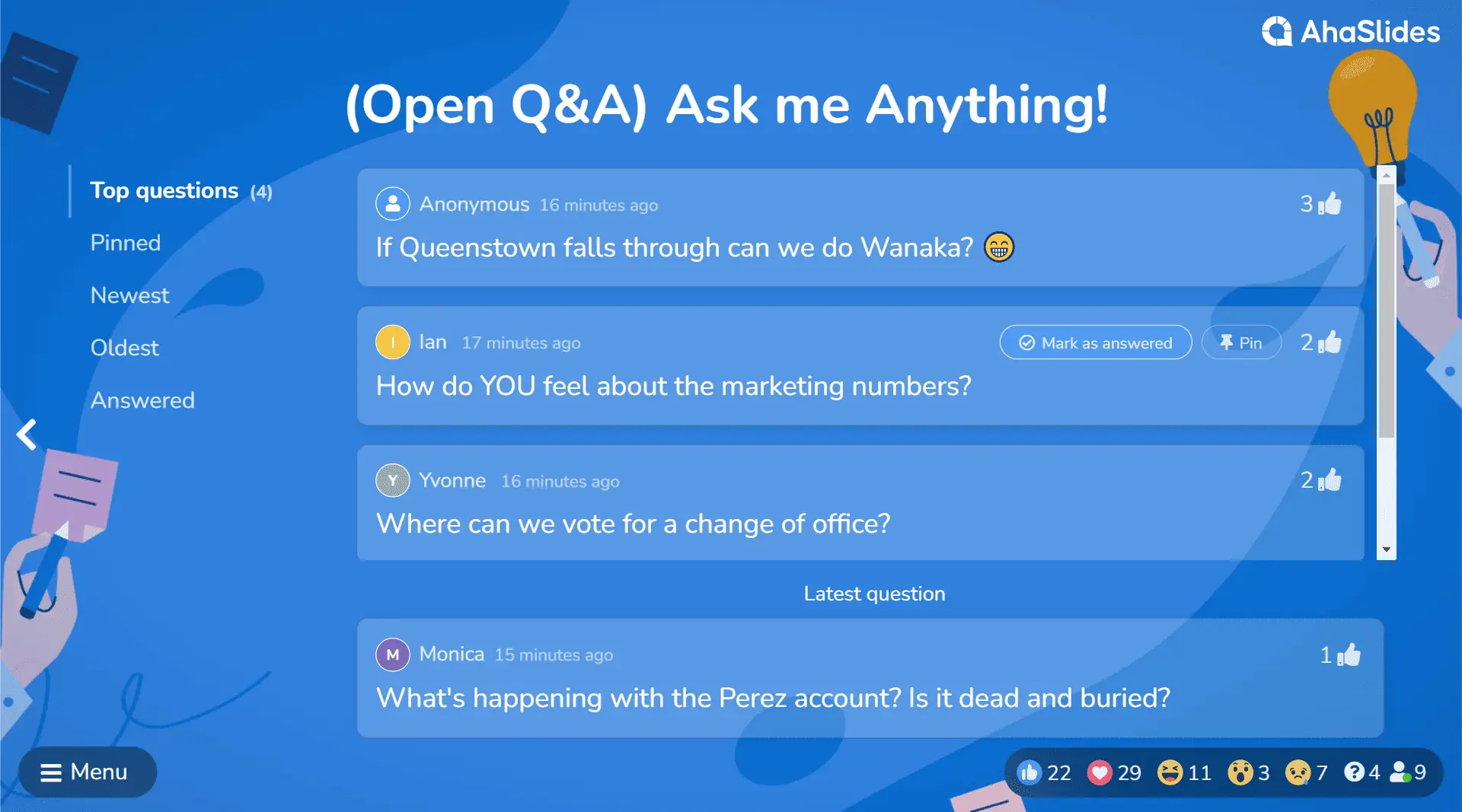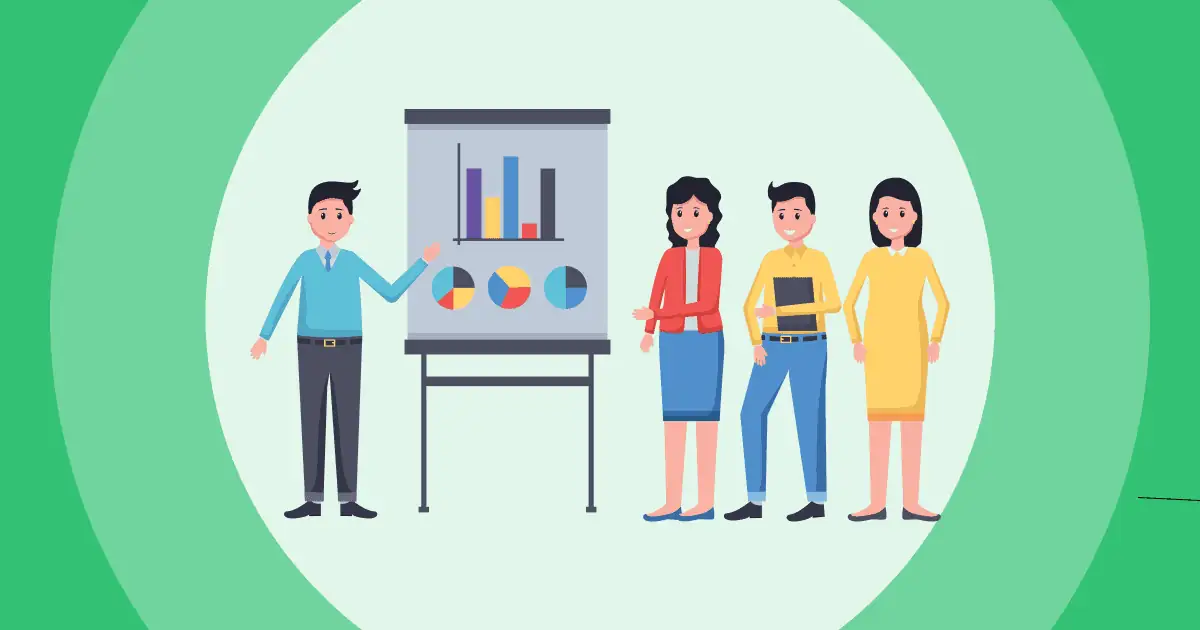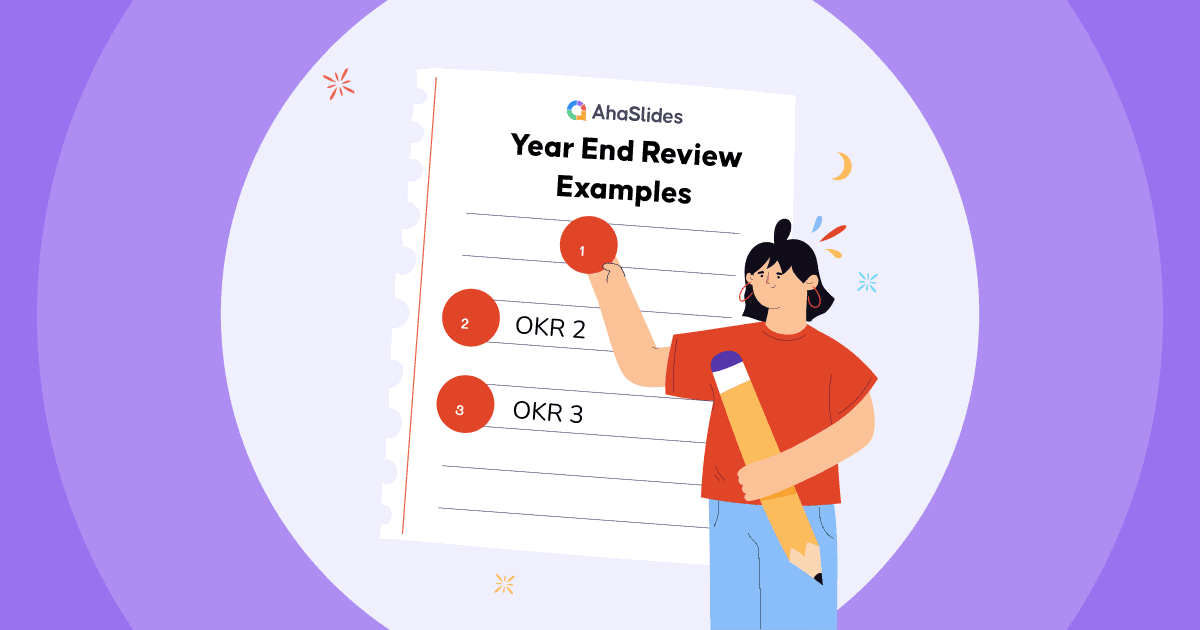So beenden Sie eine Präsentation erfolgreich? Der erste Eindruck zählt immer, und das Ende ist keine Ausnahme. Viele Präsentationen machen Fehler Ich gebe mir viel Mühe, einen großartigen Anfang zu gestalten, vergesse aber den Schluss.
In diesem Sinne möchte Ihnen dieser Artikel nützliche Tipps für eine gelungene Präsentation geben, insbesondere für einen überzeugenden und fesselnden Abschluss. Los geht‘s!
Lernen Sie, eine bessere Präsentation zu erstellen
- Schlechte Präsentation bei der Arbeit
- Lampenfieber überwinden
- Messen Sie Ihre Präsentation besser mit Bewertungsskala or Likert-Skala
Inhaltsverzeichnis
- Die Bedeutung des Endes einer Präsentation
- So beenden Sie eine Präsentation erfolgreich: Eine vollständige Anleitung mit Beispielen
- Wann sollte die Präsentation perfekt beendet werden?
- Fazit
- Häufig gestellte Fragen (FAQ)

Beteiligen Sie Ihre Schüler
Starten Sie sinnvolle Diskussionen, erhalten Sie nützliches Feedback und informieren Sie Ihr Publikum. Melden Sie sich für die kostenlose AhaSlides-Vorlage an
🚀 Holen Sie sich ein kostenloses Quiz ☁️
Die Bedeutung des Endes einer Präsentation?
Warum ist der Schluss Ihrer Präsentation so wichtig? Er ist nicht nur eine Formalität, sondern entscheidend. Im Schluss hinterlassen Sie einen bleibenden Eindruck, unterstreichen wichtige Punkte für ein besseres Gedächtnis, motivieren zum Handeln und sorgen dafür, dass Ihre Botschaft im Gedächtnis Ihres Publikums bleibt.
Darüber hinaus spiegelt ein überzeugender Schluss Ihre Professionalität wider und zeigt, dass Sie sorgfältig überlegt haben, wie Sie einen nachhaltigen Eindruck hinterlassen können. Im Wesentlichen ist es Ihre letzte Gelegenheit, effektiv zu interagieren, zu informieren und zu überzeugen und sicherzustellen, dass Ihre presentation erreicht seine Ziele und bleibt aus den richtigen Gründen in Erinnerung.
So beenden Sie eine Präsentation erfolgreich: Eine vollständige Anleitung mit Beispielen
Ein gelungener Abschluss einer Präsentation ist entscheidend, um einen bleibenden Eindruck beim Publikum zu hinterlassen und Ihre Botschaft zu vermitteln. Hier finden Sie eine Schritt-für-Schritt-Anleitung für den erfolgreichen Abschluss einer Präsentation.

Zusammenfassung der wichtigsten Punkte
Eine der Hauptfunktionen eines Fazits ist die Zusammenfassung der wichtigsten Punkte Ihrer Präsentation. Diese Zusammenfassung dient als Gedächtnisstütze und festigt die Kernaussagen für Ihr Publikum. Es ist wichtig, dies prägnant und klar zu tun, damit sich die Zuhörer die Kernideen leicht merken können. Zum Beispiel:
- Wir haben uns mit den Faktoren beschäftigt, die Motivation fördern – sinnvolle Ziele setzen, Hindernisse überwinden und eine positive Einstellung fördern. Das sind die Bausteine für ein motiviertes Leben.
- Bevor wir zum Schluss kommen, wollen wir noch einmal auf unser heutiges Kernthema zurückkommen – die unglaubliche Kraft der Motivation. Unsere Reise durch die Elemente Inspiration und Selbstmotivation war sowohl erhellend als auch ermutigend.“
* Dieser Schritt ist auch ein großartiger Ort, um eine Vision zu hinterlassenEin häufig verwendeter Satz lautet: „Stellen Sie sich eine Welt vor, in der Menschen selbstbestimmt sind, ihren Leidenschaften nachgehen und Grenzen überwinden. Es ist eine Welt, in der Motivation den Fortschritt vorantreibt und Träume wahr werden. Diese Vision ist für uns alle erreichbar.“
Einbindung eines Call-to-Action
Wie gestaltet man den Schluss einer Präsentation? Ein überzeugender Schluss, der Ihr Publikum zum Handeln motiviert, kann eine hervorragende Idee sein. Je nach Art Ihrer Präsentation könnte dies bedeuten, sie zum Kauf zu ermutigen, eine Sache zu unterstützen oder die von Ihnen vorgestellten Ideen umzusetzen. Seien Sie in Ihrem Call-to-Action konkret und formulieren Sie ihn überzeugend und umsetzbar. Ein Beispiel für einen CTA-Abschluss könnte sein:
- Jetzt ist es Zeit zu handeln. Ich ermutige jeden von euch, eure Ziele zu identifizieren, einen Plan zu erstellen und den ersten Schritt zur Verwirklichung eurer Träume zu machen. Denkt daran: Motivation ohne Taten ist nur ein Tagtraum.
Zum Schluss ein kraftvolles Zitat
Wie beendet man eine Präsentation eindrucksvoll? „Wie die große Maya Angelou einst sagte: ‚Sie können nicht alle Ereignisse kontrollieren, die Ihnen widerfahren, aber Sie können sich entscheiden, sich nicht von ihnen unterkriegen zu lassen.‘ Denken wir daran, dass wir die Kraft haben, Herausforderungen zu meistern.“ Schließen Sie mit einem relevanten und wirkungsvolles Zitat das sich auf Ihr Thema bezieht. Ein gut gewähltes Zitat kann einen bleibenden Eindruck hinterlassen und zum Nachdenken anregen. Julius Cäsar nutzte diese Technik beispielsweise, als er sagte: „Ich kam, ich sah, ich siegte.“ Einige gute Sätze für Ihren Schluss sind:
- Wenn Sie Fragen haben, können Sie sich gerne an uns wenden.“
- „Weitere Informationen finden Sie unter dem Link auf dem Bildschirm.“
- „Vielen Dank für Ihre Zeit/Aufmerksamkeit.“
- „Ich hoffe, Sie fanden diese Präsentation informativ/nützlich/aufschlussreich.“
Eine zum Nachdenken anregende Frage stellen
Wie beendet man eine Präsentation, ohne die Dankeschön-Folie zu verwenden? Stellen Sie eine Frage, die Ihr Publikum zum Nachdenken über den präsentierten Stoff anregt. Das kann das Publikum fesseln und eine Diskussion anregen.
Zum Beispiel: Sie könnten eine Aussage wie folgt beginnen: „Ich bin hier, um Ihre Fragen zu beantworten und Ihre Gedanken anzuhören. Haben Sie Fragen, Geschichten oder Ideen, die Sie gerne teilen möchten? Ihre Stimme ist wichtig, und Ihre Erfahrungen können uns alle inspirieren.“
💡Verwenden Live-Q&A-Funktionen von interaktiven Präsentationstools wie AhaSlides, um die Einbindung Ihres Publikums zu steigern. Dieses Tool ist in PowerPoint integriert und Google Slides, damit Sie es Ihrem Publikum sofort zeigen und die Antwort in Echtzeit aktualisieren können.

Vermeidung neuer Informationen
Der Schluss ist nicht der richtige Ort, um neue Informationen oder Ideen einzuführen. Dies könnte Ihr Publikum verwirren und die Wirkung Ihrer Kernbotschaft abschwächen. Bleiben Sie beim bereits Behandelten und nutzen Sie den Schluss, um den bestehenden Inhalt zu unterstreichen und hervorzuheben.
💡Schauen Sie sich an Dankeschön-Folie für PPT | Erschaffen Sie im Jahr 2024 ein wunderschönes Zuhause Erfahren Sie, wie Sie innovative und ansprechende Dankesfolien zum Abschluss jeder Art von Präsentation erstellen, sei es für akademische oder geschäftliche Zwecke.
Zusammenfassend lässt sich sagen, dass ein effektiver Schluss Ihre Präsentation prägnant zusammenfasst, Ihr Publikum zum Handeln anregt und auf neue Informationen verzichtet. Indem Sie diese drei Ziele erreichen, schaffen Sie einen Schluss, der Ihre Botschaft verstärkt und Ihr Publikum zu einer positiven Reaktion anregt.
Wann sollte die Präsentation perfekt beendet werden?
Der Zeitpunkt für den Abschluss einer Präsentation hängt von verschiedenen Faktoren ab, darunter der Art Ihres Inhalts, Ihrem Publikum und etwaigen Zeitbeschränkungen. Hier sind einige allgemeine Richtlinien, die Ihnen bei der Bestimmung des Abschlusstermins Ihrer Präsentation helfen sollen:
- Vermeiden Sie EileVermeiden Sie es, aus Zeitgründen zu schnell durch den Schluss zu gehen. Planen Sie ausreichend Zeit für den Schluss ein, damit er nicht abrupt oder übereilt wirkt.
- Überprüfen Sie die Fristen: Wenn Sie für Ihre Präsentation ein bestimmtes Zeitlimit haben, behalten Sie die Zeit genau im Auge, wenn Sie sich dem Abschluss nähern. Seien Sie darauf vorbereitet, das Tempo Ihrer Präsentation anzupassen, um sicherzustellen, dass Sie genügend Zeit für den Abschluss haben.
- Berücksichtigen Sie die Erwartungen des Publikums: Berücksichtigen Sie die Erwartungen Ihres Publikums. Wenn sie eine bestimmte Dauer Ihrer Präsentation erwarten, versuchen Sie, Ihre Schlussfolgerung mit ihren Erwartungen in Einklang zu bringen.
- Natürlich einpacken: Beenden Sie Ihre Präsentation auf eine natürliche und nicht abrupte Weise. Geben Sie ein klares Signal, dass Sie zum Schluss übergehen, um Ihr Publikum auf das Ende vorzubereiten.
Wie beendet man eine Präsentation? Der Schlüssel liegt darin, die Notwendigkeit, Ihre Botschaft effektiv zu übermitteln, mit der verfügbaren Zeit in Einklang zu bringen. Ein effektives Zeitmanagement und ein gut geplanter Abschluss helfen Ihnen, Ihre Präsentation reibungslos abzuschließen und einen positiven Eindruck bei Ihrem Publikum zu hinterlassen.
🎊 Erfahren Sie: Die besten Q&A-Apps zur Interaktion mit Ihrem Publikum | 5+ Plattformen kostenlos im Jahr 2024
Fazit
Wie beendet man eine Präsentation Ihrer Meinung nach eindrucksvoll? Wie bereits erwähnt, gibt es viele Möglichkeiten, Ihr Publikum bis zur letzten Minute zu fesseln – von einem starken CTA über eine fesselnde Schlussfolie bis hin zu einer durchdachten Frage-und-Antwort-Runde. Zwingen Sie sich nicht zu einem Schluss, mit dem Sie sich vielleicht nicht wohlfühlen, sondern bleiben Sie so natürlich wie möglich.
💡Möchten Sie mehr Inspiration? Kasse AhaFolien Entdecken Sie sofort weitere innovative Methoden zur Verbesserung des Publikumsengagements und der Zusammenarbeit!
Häufig gestellte Fragen (FAQ)
Was sagen Sie am Ende einer Präsentation?
Am Ende einer Präsentation sagen Sie normalerweise ein paar wichtige Dinge:
- Fassen Sie Ihre wichtigsten Punkte oder wichtigsten Erkenntnisse zusammen, um die Botschaft zu verstärken.
- Geben Sie einen klaren Aufruf zum Handeln und motivieren Sie Ihr Publikum, bestimmte Schritte zu unternehmen.
- Drücken Sie Ihre Dankbarkeit aus und danken Sie Ihrem Publikum für seine Zeit und Aufmerksamkeit.
- Öffnen Sie optional das Wort für Fragen oder Kommentare und laden Sie so zum Engagement des Publikums ein.
Wie beendet man eine unterhaltsame Präsentation?
Zum Abschluss einer unterhaltsamen Präsentation können Sie einen unbeschwerten, relevanten Witz oder eine humorvolle Anekdote erzählen, das Publikum dazu ermutigen, seine eigenen lustigen oder unvergesslichen Erlebnisse im Zusammenhang mit dem Thema zu teilen, mit einem spielerischen oder aufmunternden Zitat abschließen und Ihre Begeisterung und Wertschätzung zum Ausdruck bringen für ein angenehmes Präsentationserlebnis.
Sollte man sich am Ende einer Präsentation bedanken?
Ja, sich am Ende einer Präsentation zu bedanken, ist eine höfliche und wertschätzende Geste. Es würdigt die Zeit und Aufmerksamkeit Ihres Publikums und verleiht Ihrem Abschluss eine persönliche Note. Es kann besonders bei Dankespräsentationen wichtig sein und ist generell eine höfliche Art, jede Art von Präsentation abzuschließen.
Ref: Pumple








